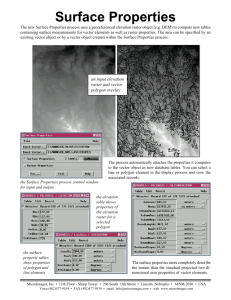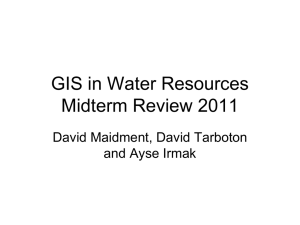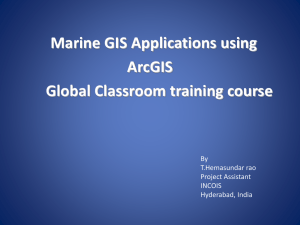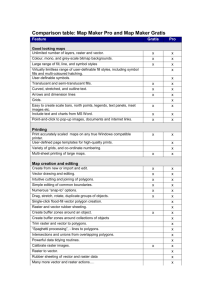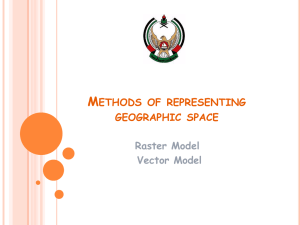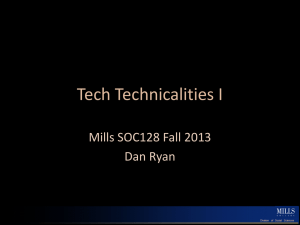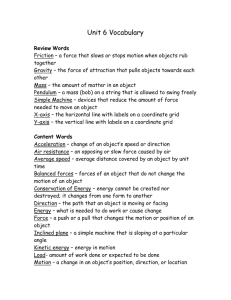Review2013
advertisement
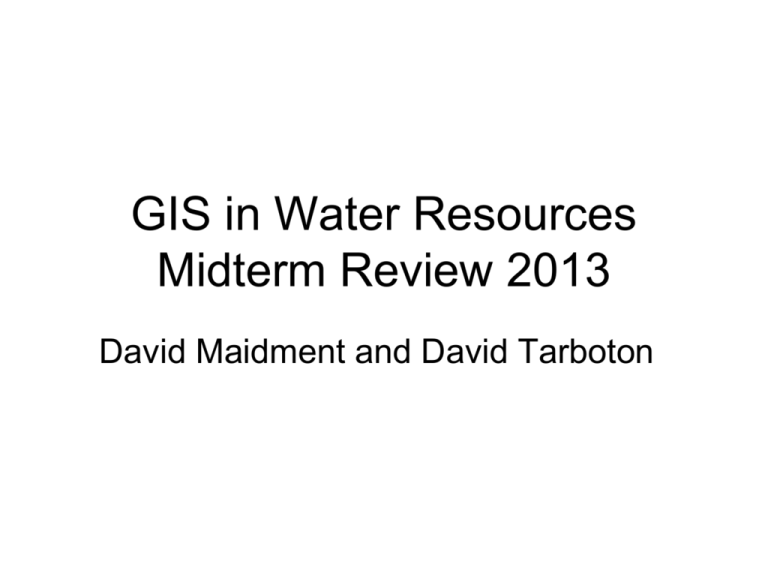
GIS in Water Resources Midterm Review 2013 David Maidment and David Tarboton Review for Midterm Exam • Location on the Earth • ArcGIS as a Geographic Information System • Working with Raster Data • Working with Vector Data Review for Midterm Exam • Location on the Earth • ArcGIS as a Geographic Information System • Working with Raster Data • Working with Vector Data Latitude and Longitude on a Spherical Earth Longitude line (Meridian) N W E S Range: 180ºW - 0º - 180ºE Latitude line (Parallel) N W E S Range: 90ºS - 0º - 90ºN (0ºN, 0ºE) Equator, Prime Meridian Origin of Geographic Coordinates Equator (0,0) Prime Meridian Length on Meridians and Parallels (Spherical Earth) (Lat, Long) = (f, l) Length on a Meridian: AB = Re Df (same for all latitudes) R Dl Re Length on a Parallel: CD = R Dl = Re Dl Cos f (varies with latitude) R C Df B Re A D Example: What is the length of a 1º increment along on a meridian and on a parallel at 30N, 90W? Radius of the earth = 6370 km. Solution: • A 1º angle has first to be converted to radians p radians = 180 º, so 1º = p/180 = 3.1416/180 = 0.0175 radians • For the meridian, DL = Re Df = 6370 * 0.0175 = 111 km • For the parallel, DL = Re Dl Cos f = 6370 * 0.0175 * Cos 30 = 96.5 km • Parallels converge as poles are approached Shape of the Earth We think of the earth as a sphere It is actually a spheroid, slightly larger in radius at the equator than at the poles Ellipse An ellipse is defined by: Focal length = Distance (F1, P, F2) is constant for all points on ellipse When = 0, ellipse = circle For the earth: Major axis, a = 6378 km Minor axis, b = 6357 km Flattening ratio, f = (a-b)/a ~ 1/300 Z b O F1 P a X F2 Ellipsoid or Spheroid Rotate an ellipse around an axis Z b a O a X Rotational axis Y Horizontal Earth Datums • An earth datum is defined by an ellipse and an axis of rotation • NAD27 (North American Datum of 1927) uses the Clarke (1866) ellipsoid on a non geocentric axis of rotation • NAD83 (NAD,1983) uses the GRS80 ellipsoid on a geocentric axis of rotation • WGS84 (World Geodetic System of 1984) uses GRS80, almost the same as NAD83 Definition of Latitude, f m O q f S p n r (1) Take a point S on the surface of the ellipsoid and define there the tangent plane, mn (2) Define the line pq through S and normal to the tangent plane (3) Angle pqr which this line makes with the equatorial plane is the latitude f, of point S Cutting Plane of a Meridian P Prime Meridian Equator Meridian Definition of Longitude, l l = the angle between a cutting plane on the prime meridia and the cutting plane on the meridian through the point, P -150° 180°E, W 150° -120° 120° 90°W (-90 °) 90°E (+90 °) P -60° l -30° -60° 30° 0°E, W Global Positioning Systems Distance to four satellites gives (x,y,z) Revolution in Earth Measurement Some images and slides from Michael Dennis, National Geodetic Survey and Lewis Lapine, South Carolina Geodetic Survey Traditional Surveying uses benchmarks as reference points Global Positioning uses fixed GPS receivers as reference points (Continuously Operating Reference System, CORS) HORIZONTAL TECTONIC MOTIONS Motion in cm/year North American Plate Pacific Plate When is California not in North America … …. when its on the Pacific Plate! Representations of the Earth Geoid is a surface of constant gravitational potential ~ Sea surface Ellipsoid Earth surface Geoid Definition of Elevation Elevation Z P • z = zp z = 0 Land Surface Mean Sea level = Geoid Elevation is measured from the Geoid Vertical Earth Datums • A vertical datum defines elevation, z • NGVD29 (National Geodetic Vertical Datum of 1929) • NAVD88 (North American Vertical Datum of 1988) • The National Elevation Dataset is in the NAVD88 datum • Heights are “elevation above datum” Geodesy and Map Projections • Geodesy - the shape of the earth and definition of earth datums • Map Projection - the transformation of a curved earth to a flat map • Coordinate systems - (x,y) coordinate systems for map data Earth to Globe to Map Map Scale: Map Projection: Scale Factor Representative Fraction = Globe distance Earth distance (e.g. 1:24,000) = Map distance Globe distance (e.g. 0.9996) Types of Projections • Conic (Albers Equal Area, Lambert Conformal Conic) - good for East-West land areas • Cylindrical (Transverse Mercator) - good for North-South land areas • Azimuthal (Lambert Azimuthal Equal Area) - good for global views Projections Preserve Some Earth Properties • Area - correct earth surface area (Albers Equal Area) important for mass balances • Shape - local angles are shown correctly (Lambert Conformal Conic) • Direction - all directions are shown correctly relative to the center (Lambert Azimuthal Equal Area) • Distance - preserved along particular lines • Some projections preserve two properties Web Mercator Projection (used for ESRI Basemaps) Web Mercator is one of the most popular coordinate systems used in web applications because it fits the entire globe into a square area that can be covered by 256 by 256 pixel tiles. The spatial reference for the ArcGIS Online / Google Maps / Bing Maps tiling scheme is WGS 1984 Web Mercator (Auxiliary Sphere). Coordinate Systems A planar coordinate system is defined by a pair of orthogonal (x,y) axes drawn through an origin Y X Origin (xo,yo) (fo,lo) State Plane Coordinate System • Defined for each State in the United States • East-West States (e.g. Texas) use Lambert Conformal Conic, North-South States (e.g. California) use Transverse Mercator • Texas has five zones (North, North Central, Central, South Central, South) to give accurate representation • Greatest accuracy for local measurements Review for Midterm Exam • Location on the Earth • ArcGIS as a Geographic Information System • Working with Raster Data • Working with Vector Data What is GIS • A geographic information system (GIS) is a system designed to capture, store, manipulate, analyze, manage, and present all types of geographical data. -- Wikipedia computers data maps tools Geography is visualized in maps map www.arcgis.com Maps are built from data Road Name: E. Dean Keeton St Type: Div Highway Speed: 35 mph Shape: [Geometry] Building Name: Ernest Cockrell Jr Hall Address: 301 E. Dean Keeton St Shape: [Geometry] Shape includes the geometry of the feature and where it is located on earth data map Vector data represent discrete features points data polygons map Raster data form a grid of cells or pixels data map Data Model Conceptual Model – a set of concepts that describe a subject and allow reasoning about it Mathematical Model – a conceptual model expressed in symbols and equations Data Model – a conceptual model expressed in a data structure (e.g. ascii files, Excel tables, …..) Geographic Data Model – a conceptual model for describing and reasoning about the world expressed in a GIS database Linking Geography and Attributes • GIS has a one to one association between a geographic feature and a record in an attribute table. Geographic coordinates Tabular attributes Data Model based on Inventory of data layers Common Geospatial Information Types Image: Michael Zeiler, ESRI Raster and Vector Data Raster data are described by a cell grid, one value per cell Vector Raster Point Line Zone of cells Polygon Geodatabase – a store for all types of geospatial information Geodesy, Map Projections and Coordinate Systems • Geodesy - the shape of the earth and definition of earth datums • Map Projection - the transformation of a curved earth to a flat map • Coordinate systems - (x,y) coordinate systems for map data Spatial Reference = Datum + Projection + Coordinate system ArcGIS Spatial Reference Frames • Defined for a feature dataset in ArcCatalog • XY Coordinate System – Projected – Geographic • Z Coordinate system Horizontal Coordinate Systems • Geographic coordinates (decimal degrees) • Projected coordinates (length units, ft or meters) Key ArcGIS Software Components • • • • • ArcMap ArcCatalog ArcToolbox Extensions Geoprocessing Arc Toolbox Tools for commonly used tasks Map Projections Spatial Analyst • Analysis of land surface terrain as a grid • Key means of defining drainage areas and connectivity to stream network Geo-Processing Toolbox tools linked together using the model builder to automate data processing Web-centered GIS ArcGIS Online Review for Midterm Exam • Location on the Earth • ArcGIS as a Geographic Information System • Working with Raster Data • Working with Vector Data • Remote Sensing Spatial Analysis Using Grids Two fundamental ways of representing geography are discrete objects and fields. The discrete object view represents the real world as objects with well defined boundaries in empty space. (x1,y1) Points Lines Polygons The field view represents the real world as a finite number of variables, each one defined at each possible position. f ( y) = f ( x, y)dx x = Continuous surface Numerical representation of a spatial surface (field) Grid TIN Contour and flowline Grid Datasets • Cellular-based data structure composed of square cells of equal size arranged in rows and columns. • The grid cell size and extent (number of rows and columns), as well as the value at each cell have to be stored as part of the grid definition. Number of rows Number of columns Cell size Raster Calculator Cell by cell evaluation of mathematical functions 100 m Nearest Neighbor Resampling with Cellsize Maximum of Inputs 40 50 55 40-0.5*4 = 38 42 47 43 55-0.5*6 = 52 150 m 42 44 41 6 2 4 52 41 39 42-0.5*2 = 41 41-0.5*4 = 39 4 38 Interpolation Estimate values between known values. A set of spatial analyst functions that predict values for a surface from a limited number of sample points creating a continuous raster. Apparent improvement in resolution may not be justified Interpolation methods • Nearest neighbor • Inverse distance z = 1 z i ri weight • Bilinear z = (a bx )( c dy) interpolation • Kriging (best linearz = w z i i unbiased estimator) z = ci xei yei • Spline Nearest Neighbor “Thiessen” Polygon Interpolation Spline Interpolation Topographic Slope • Defined or represented by one of the following – Surface derivative z – Vector with x and y components – Vector with magnitude (slope) and direction (aspect) ArcGIS “Slope” tool a b c d e f g h i dz (a 2d g) - (c 2f i) = dx 8 * x_mesh_spa cing dz (g 2h i) - (a 2b c) = dy 8 * y_mesh_sp acing 2 rise dz dz = run dx dy 2 rise deg = atan run DEM Based Watershed and Stream Network Delineation Steps • DEM Reconditioning/Burning in Streams • Fill Sinks • Eight direction pour point model to evaluate flow directions • Flow accumulation • Threshold stream network definition • Stream segmentation • Watershed delineation • Raster to vector conversion of streams and watersheds Digital Elevation Model (DEM)-30 meter National Elevation Dataset Filling in the Pits • DEM creation results in artificial pits in the landscape • A pit is a set of one or more cells which has no downstream cells around it • Unless these pits are filled they become sinks and isolate portions of the watershed • Pit filling is first thing done with a DEM Identifying and Removing Pits/Sinks in a DEM Contains pits Filled 5 5 4 5 5 5 5 3 5 5 5 5 4 5 5 5 5 3 5 5 6 6 5 6 6.1 5 6 6 6 6 6 6 5 6 6.1 5 6 6 6 6 7 7 6 7 7 4 7 5 7 7 7 7 6 7 7 4 7 6 7 7 9 9 8 9 9 3.9 9 5 9 9 9 9 8 9 9 3.9 9 6 9 9 11 11 10 11 11 11 11 9 11 11 11 11 10 11 11 11 11 9 11 11 12 12 8 12 12 12 12 10 12 12 12 12 9 12 12 12 12 10 12 12 13 12 7 12 13 13 13 11 13 13 13 12 9 12 13 13 13 11 13 13 14 7 6 11 14 14 14 12 14 14 14 9 9 11 14 14 14 12 14 14 15 7 7 8 9 15 15 8 15 15 15 9 9 9 9 15 15 12 15 15 15 8 8 8 7 16 16 14 16 16 15 9 9 9 9 16 16 14 16 16 15 11 9 11 11 17 17 17 17 17 15 11 9 11 11 17 17 17 17 17 15 15 8 15 15 18 18 15 18 18 15 15 8 15 15 18 18 15 18 18 A pit is a set of one or more cells which has no downstream cells around it. Hydrologic Slope - Direction of Steepest Descent 30 30 67 56 49 67 56 49 52 48 37 52 48 37 58 55 22 58 55 22 67 48 = 0.45 Slope: 30 2 67 52 = 0.50 30 Eight Direction Pour Point Model 32 64 16 8 128 1 4 2 Water flows in the direction of steepest descent Flow Accumulation Grid. Area draining in to a grid cell 0 0 0 0 0 0 0 2 2 2 0 0 0 0 10 0 1 0 0 1 0 0 14 0 1 0 0 4 1 19 1 0 0 0 2 2 10 0 4 0 0 2 0 0 1 14 1 19 0 1 Flow Accumulation > Threshold ArcHydro Page 72 Watershed Draining to Outlet Stream links grid for the San Marcos subbasin 201 172 202 203 206 204 209 Each link has a unique identifying number Review for Midterm Exam • Location on the Earth • ArcGIS as a Geographic Information System • Working with Raster Data • Working with Vector Data Data Sources for GIS in Water Resources National Hydro Data Programs National Elevation Dataset (NED) National Hydrography Dataset (NHD) What is it? What does it contain? What is the GIS format? Where would it be obtained NED-Hydrology Watershed Boundary Dataset Watershed Boundary Dataset for Nebraska 2990 HUC12 watersheds of average area 39.3 square miles HUC12:HUC8 ~ 40:1 watersheds SSURGO: County Level Digital Soil Maps 1:24,000 scale soil information http://www.soils.usda.gov/survey/geography/ssurgo/ Ssurgo for Lancaster County, NE 96 soil map units described by 18,565 polygons Catchments for Stream Links Same Cell Value Vectorized Streams Linked Using Grid Code to Cell Equivalents Vector Streams Grid Streams Raster Zones and Vector Polygons One to one connection Raster pixel value Catchment Grid_code 4 3 5 Raster Zones Vector Polygons Relationship • A relationship is an association or link between two objects in a database. • A relationship can exist between spatial objects (features in feature classes), nonspatial objects (objects in object classes), or between spatial and non-spatial objects. Relationships linking Catchments and Drainage Lines Zonal Average of Raster over Subwatershed joined to Subwatershed table Join Catchment, Watershed, Subwatershed. Subwatersheds Catchments Watershed Watershed outlet points may lie within the interior of a catchment, e.g. at a USGS stream-gaging site. Connecting Land and Water • Four key ideas: – Cell to cell water movement on DEMs – Line to Line water movement on networks – Area flows to line (connect land and water systems – Reach Catchments) – Area flows to point on line (Watershed delineation from designated points) Cell Flows to a Cell Core concept of flow on digital elevation models Line Flows to a Line Geometric Network of NHDFlowlines Area Flows to a Line Reach Catchments from NHDPlus Flowline and Catchment have the same COMID Area Flows to a Point on a Line Watersheds for USGS Gages Network Model in GIS • Three components – Geometric model: (x,y,z,m) coordinates of edges and junctions – Logical model: which edges are connected to what junctions – Addressing model: location on the network using measure Connectivity Table J125 Junction J123 Adjacent Junction and Edge J124, E1 J124 J124 J123, E1 J125, E2 J126, E3 E1 J125 E2 E3 J124, E2 J123 J126 J126 J124, E3 This is the “Logical Network” Upstream Trace Solvers Network Tracing on the Guadalupe Basin Addressing
